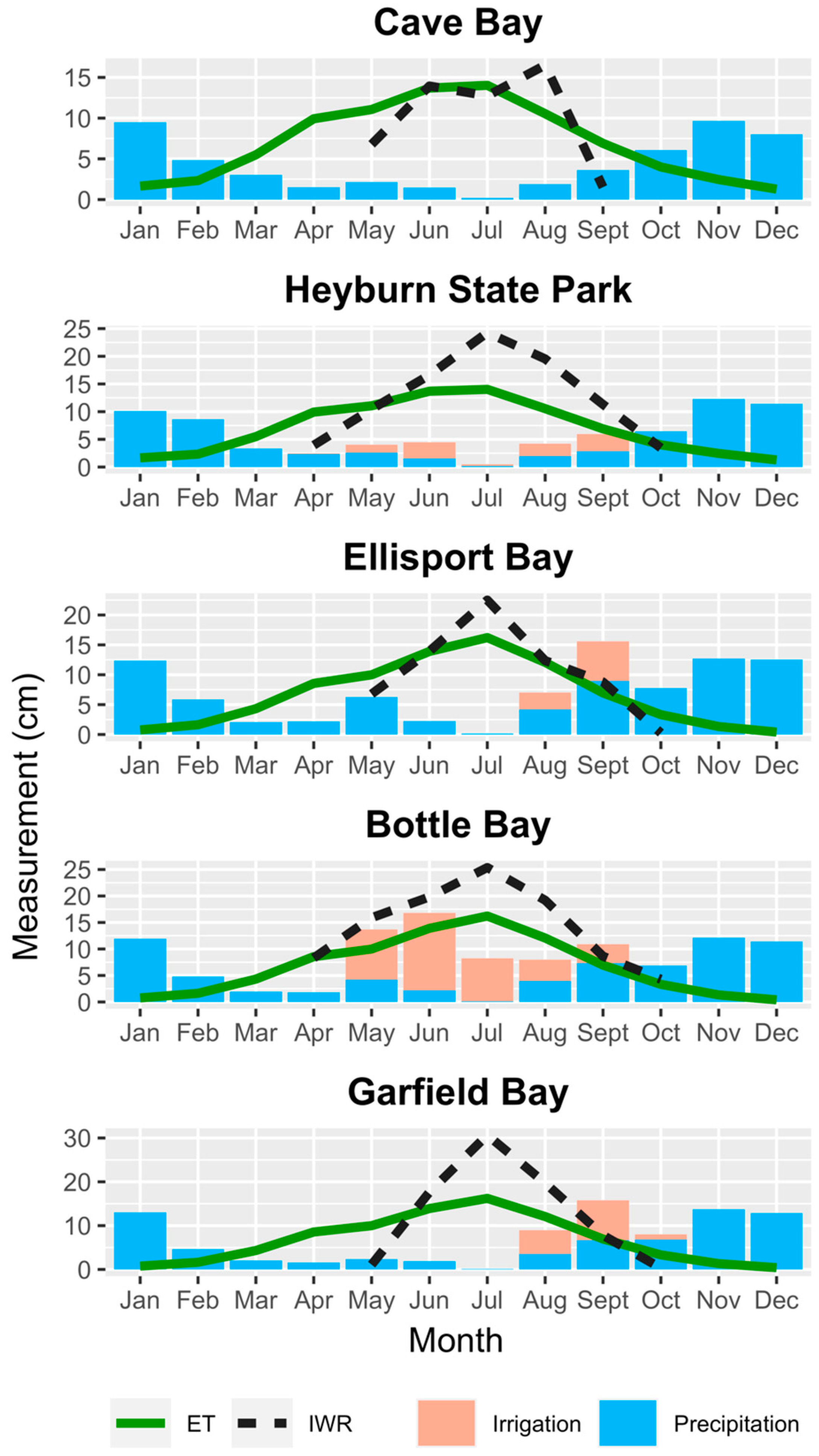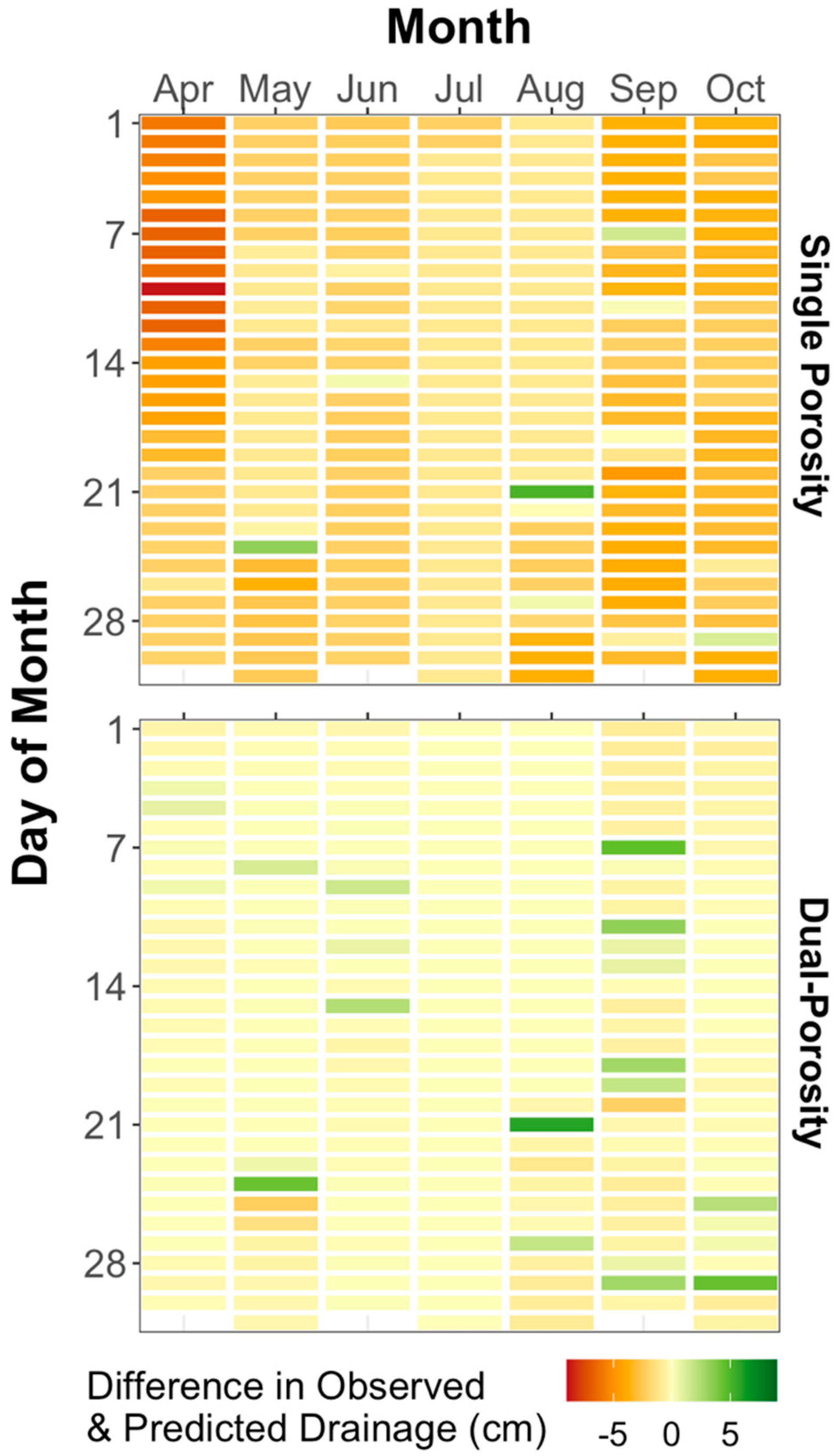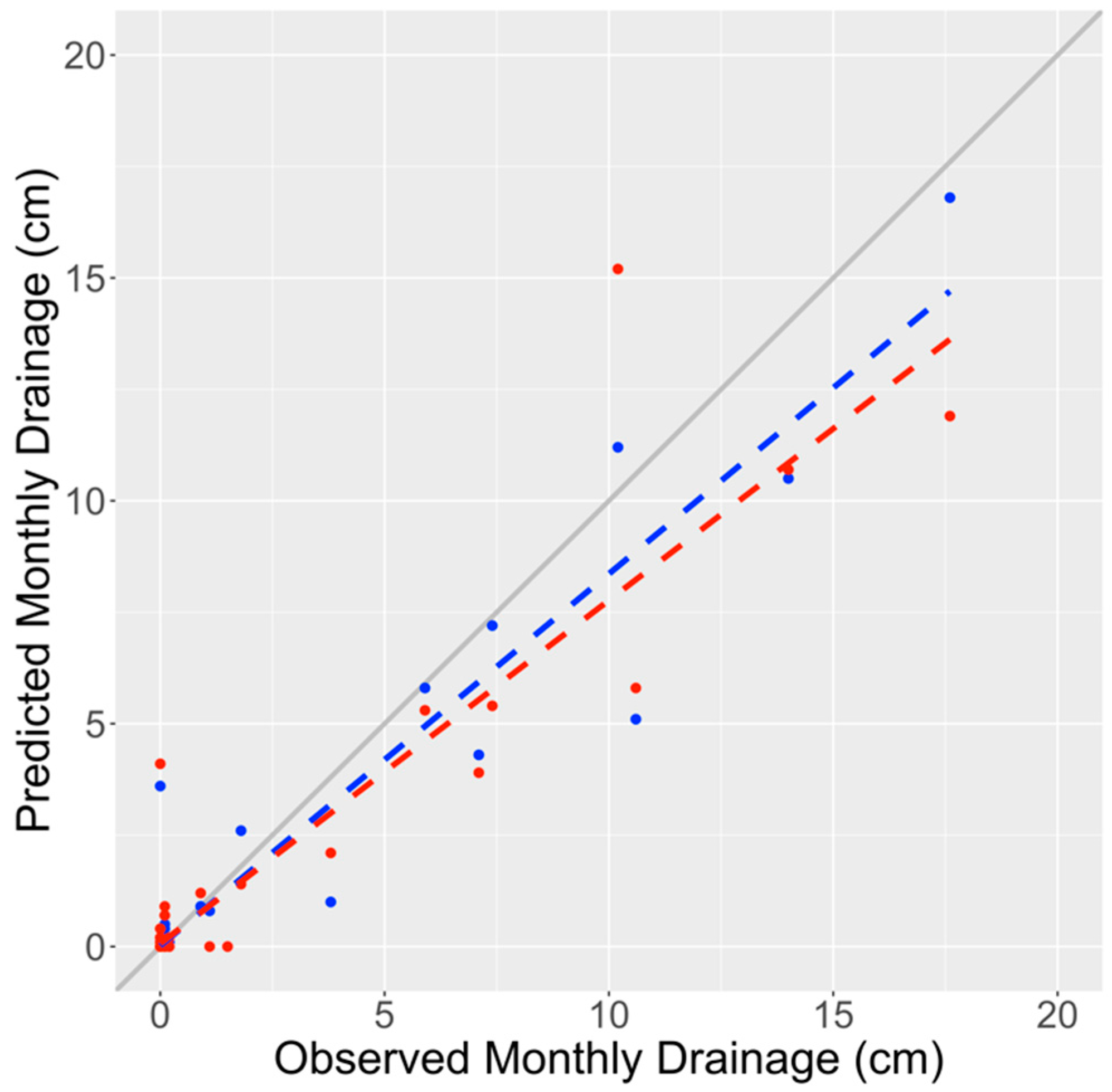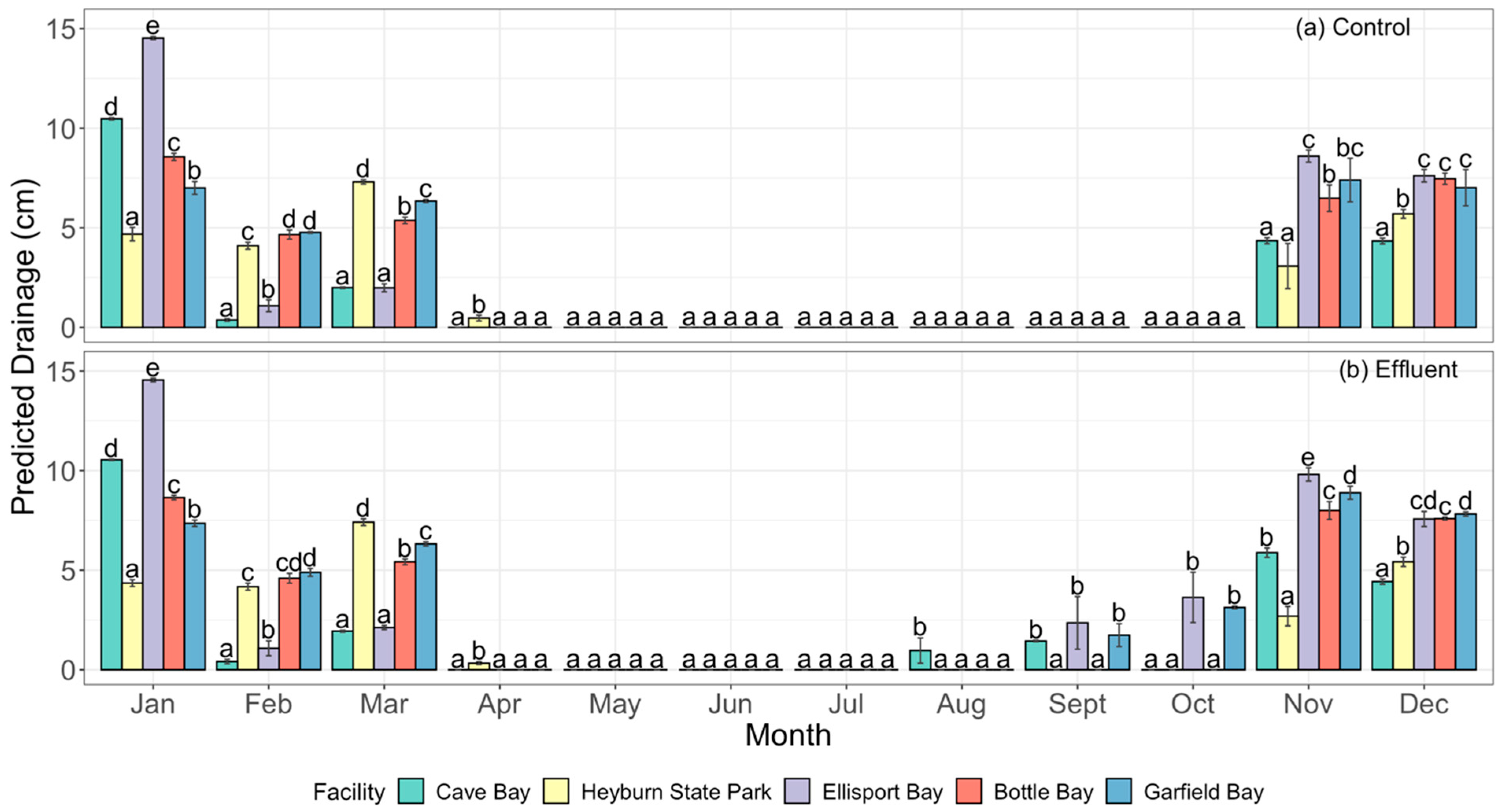Estimating Drainage from Forest Water Reclamation Facilities Based on Drain Gauge Measurements
Abstract
:1. Introduction
2. Materials and Methods
2.1. Study Area
2.2. Data Collection
2.3. Predicting Drainage
2.4. Data Analysis
3. Results
3.1. Soil Moisture and Temperature
3.2. Observed Drainage
3.3. Parameterized Model Runs
3.4. Simulated Model Runs
4. Discussion
4.1. Observed Drainage
4.2. Predicted Drainage and Assessment of Models
5. Conclusions
Supplementary Materials
Author Contributions
Funding
Data Availability Statement
Acknowledgments
Conflicts of Interest
References
- EPA. Guidelines for Water Reuse; EPA: Washington, DC, USA, 2012; pp. 1–643.
- Wang, J.; Wang, G.; Wanyan, H. Treated wastewater irrigation effect on soil, crop and environment: Wastewater recycling in the loess area of China. J. Environ. Sci. 2007, 19, 1093–1099. [Google Scholar] [CrossRef]
- Singh, P.; Deshbhratar, P.; Ramteke, D. Effects of sewage wastewater irrigation on soil properties, crop yield and environment. Agric. Water Manag. 2012, 103, 100–104. [Google Scholar] [CrossRef]
- Kim, D.Y.; Burger, J.A. Nitrogen transformations and soil processes in a wastewater-irrigated, mature Appalachian hardwood forest. For. Ecol. Manag. 1997, 90, 1–11. [Google Scholar] [CrossRef]
- Brister, G.; Schultz, R. The response of a southern Appalachian forest to waste water irrigation. J. Environ. Qual. 1981, 10, 148–153. [Google Scholar] [CrossRef]
- Isebrands, J.G.; Richardson, J. Poplars and Willows: Trees for Society and the Environment; CABI: Rome Italy, 2014. [Google Scholar]
- Gessel, S.; Miller, R.; Cole, D. Relative importance of water and nutrients on the growth of coast Douglas fir in the Pacific Northwest. For. Ecol. Manag. 1990, 30, 327–340. [Google Scholar] [CrossRef]
- Hesse, I.; Day, J.; Doyle, T. Long-term growth enhancement of baldcypress (Taxodium distichum) from municipal wastewater application. Environ. Manag. 1998, 22, 119–127. [Google Scholar] [CrossRef]
- Joshi, E.; Coleman, M.D. Tree Growth and Vegetation Diversity in Northern Idaho Forest Water Reclamation Facilities. Forests 2023, 14, 266. [Google Scholar] [CrossRef]
- Jones, H.G. Irrigation scheduling: Advantages and pitfalls of plant-based methods. J. Exp. Bot. 2004, 55, 2427–2436. [Google Scholar] [CrossRef]
- IDEQ. Guidance for Reclamation and Reuse of Municipal and Industrial Wastewater; IDEQ: Boise, ID, USA, 2007; pp. 1–563.
- Docktor, D.; Palmer, P.L. Computation of the 1982 Kimberly-Penman and the Jensen-Haise Evapotranspiration Equations as Applied in the U.S. Bureau of Reclamation’s Pacific Northwest AgriMet Program; U.S. Bureau of Reclamation, Pacific Northwest Region, Water Conservation Center: Boise, ID, USA, 1994; pp. 1–28. [Google Scholar]
- Pangle, R.; Kavanagh, K.; Duursma, R. Decline in canopy gas exchange with increasing tree height, atmospheric evaporative demand, and seasonal drought in co-occurring inland Pacific Northwest conifer species. Can. J. For. Res. 2015, 45, 1086–1101. [Google Scholar] [CrossRef]
- Running, S.W.; Nemani, R.R.; Peterson, D.L.; Band, L.E.; Potts, D.F.; Pierce, L.L.; Spanner, M.A. Mapping regional forest evapotranspiration and photosynthesis by coupling satellite data with ecosystem simulation. Ecology 1989, 70, 1090–1101. [Google Scholar] [CrossRef]
- Di Baccio, D.; Minnocci, A.; Sebastiani, L.; Carraro, V.; Grani, F.; Anfodillo, T.; Tognetti, R. Sap flow measurements for the evaluation of poplar clone performance in remediation of soil polluted with olive mill wastewater. In Proceedings of the VIII International Symposium on Sap Flow 951, Volterra, Italy, 8–12 May 2011; pp. 175–181. [Google Scholar]
- Al-Jamal, M.; Sammis, T.; Mexal, J.; Picchioni, G.; Zachritz, W. A growth-irrigation scheduling model for wastewater use in forest production. Agric. Water Manag. 2002, 56, 57–79. [Google Scholar] [CrossRef]
- Birch, A.L.; Emanuel, R.E.; James, A.L.; Nichols, E.G. Hydrologic impacts of municipal wastewater irrigation to a temperate forest watershed. J. Environ. Qual. 2016, 45, 1303–1312. [Google Scholar] [CrossRef] [PubMed]
- Roygard, J.; Bolan, N.; Clothier, B.; Green, S.; Sims, R. Short rotation forestry for land treatment of effluent: A lysimeter study. Soil Res. 1999, 37, 983–992. [Google Scholar] [CrossRef]
- Lai, X.; Liao, K.; Feng, H.; Zhu, Q. Responses of soil water percolation to dynamic interactions among rainfall, antecedent moisture and season in a forest site. J. Hydrol. 2016, 540, 565–573. [Google Scholar] [CrossRef]
- Hardie, M.A.; Cotching, W.E.; Doyle, R.B.; Holz, G.; Lisson, S.; Mattern, K. Effect of antecedent soil moisture on preferential flow in a texture-contrast soil. J. Hydrol. 2011, 398, 191–201. [Google Scholar] [CrossRef]
- Joshi, E.; Schwarzbach, M.R.; Briggs, B.; Coats, E.R.; Coleman, M.D. Nutrient Leaching Potential Along a Time Series of Forest Water Reclamation Facilities in Northern Idaho. J. Environ. Manag. in revision.
- Gee, G.W.; Zhang, Z.; Ward, A.L.; Keller, J.M. Passive-wick water fluxmeters: Theory and practice. In Proceedings of the SuperSoil 2004: 3rd Australian New Zealand Soils Conference, Sydney, Australia, 5–9 December 2004. [Google Scholar]
- Gee, G.W.; Newman, B.D.; Green, S.; Meissner, R.; Rupp, H.; Zhang, Z.; Keller, J.M.; Waugh, W.; Van der Velde, M.; Salazar, J. Passive wick fluxmeters: Design considerations and field applications. Water Resour. Res. 2009, 45, W04420. [Google Scholar] [CrossRef]
- Zhu, Y.; Fox, R.; Toth, J. Leachate collection efficiency of zero-tension pan and passive capillary fiberglass wick lysimeters. Soil Sci. Soc. Am. J. 2002, 66, 37–43. [Google Scholar]
- Meissner, R.; Rupp, H.; Seeger, J.; Ollesch, G.; Gee, G. A comparison of water flux measurements: Passive wick-samplers versus drainage lysimeters. Eur. J. Soil Sci. 2010, 61, 609–621. [Google Scholar] [CrossRef]
- Hall, F. Protocol for Deployment and Operation of Deep Soil Percolation Sampler; Trim Number: 2018AGS1; Idaho Department of Environmental Quality: Idaho Falls, ID, USA, 2018; p. 43. [Google Scholar]
- Clark, M.R. Measuring and Modeling Drainage in North Idaho Forest Water Reclamation Facilities; University of Idaho, ProQuest Dissertations Publishing: Moscow, ID, USA, 2022. [Google Scholar]
- Schwarzbach, M.R. Forest Water Reclamation Project Dataset. 2023. [CrossRef]
- USBR. AgriMet Weather Data. Available online: https://www.usbr.gov/pn/agrimet/h2ouse.html (accessed on 8 May 2024).
- PRISM. Time Series Values for Individual Locations. Available online: https://www.prism.oregonstate.edu/explorer/ (accessed on 8 May 2024).
- Lew, R.; Dobre, M.; Srivastava, A.; Brooks, E.S.; Elliot, W.J.; Robichaud, P.R.; Flanagan, D.C. WEPPcloud: An online watershed-scale hydrologic modeling tool. Part I. Model description. J. Hydrol. 2022, 608, 127603. [Google Scholar] [CrossRef]
- NRCS. Web Soil Survey. Available online: https://websoilsurvey.sc.egov.usda.gov/App/WebSoilSurvey.aspx (accessed on 8 May 2024).
- Clark, M.R. Predicting Soil Hydraulic Conductivity with RETC. Available online: https://youtu.be/PssFBRm5h5Q (accessed on 8 May 2024).
- Schaap, M.G.; Leij, F.J.; Van Genuchten, M.T. Neural network analysis for hierarchical prediction of soil hydraulic properties. Soil Sci. Soc. Am. J. 1998, 62, 847–855. [Google Scholar] [CrossRef]
- van Genuchten, M.T.; Leij, F.J.; Yates, S.R. The RETC Code for Quantifying the Hydraulic Functions of Unsaturated Soils; U.S. Environmental Protection Agency: Washington, DC, USA, 1991; 93p. [Google Scholar]
- Molina, A.J.; del Campo, A.D. The effects of experimental thinning on throughfall and stemflow: A contribution towards hydrology-oriented silviculture in Aleppo pine plantations. For. Ecol. Manag. 2012, 269, 206–213. [Google Scholar] [CrossRef]
- Fan, J.; Oestergaard, K.T.; Guyot, A.; Jensen, D.G.; Lockington, D.A. Spatial variability of throughfall and stemflow in an exotic pine plantation of subtropical coastal Australia. Hydrol. Process. 2015, 29, 793–804. [Google Scholar] [CrossRef]
- Feddes, R.A. Simulation of Field Water Use and Crop Yield. In Simulation of Plant Growth and Crop Production; Pudoc: Wageningen, The Netherlands, 1982; pp. 194–209. [Google Scholar]
- Jackson, R.B.; Canadell, J.; Ehleringer, J.R.; Mooney, H.; Sala, O.; Schulze, E.-D. A global analysis of root distributions for terrestrial biomes. Oecologia 1996, 108, 389–411. [Google Scholar] [CrossRef] [PubMed]
- Moriasi, D.N.; Arnold, J.G.; Van Liew, M.W.; Bingner, R.L.; Harmel, R.D.; Veith, T.L. Model evaluation guidelines for systematic quantification of accuracy in watershed simulations. Trans. ASABE 2007, 50, 885–900. [Google Scholar] [CrossRef]
- Cook, F.; Kelliher, F.; McMahon, S. Changes in infiltration and drainage during wastewater irrigation of a highly permeable soil. J. Environ. Qual. 1994, 23, 476–482. [Google Scholar] [CrossRef]
- Nimmo, J.R. The processes of preferential flow in the unsaturated zone. Soil Sci. Soc. Am. J. 2021, 85, 1–27. [Google Scholar] [CrossRef]
- Schmidt, A.; Mainwaring, D.B.; Maguire, D.A. Development of a tailored combination of machine learning approaches to model volumetric soil water content within a mesic forest in the Pacific Northwest. J. Hydrol. 2020, 588, 125044. [Google Scholar] [CrossRef]
- Sutinen, R.; Hänninen, P.; Venäläinen, A. Effect of mild winter events on soil water content beneath snowpack. Cold Reg. Sci. Technol. 2008, 51, 56–67. [Google Scholar] [CrossRef]
- Teskey, R.O.; Hinckley, T.M.; Grier, C.C. Temperature-induced change in the water relations of Abies amabilis (Dougl.) Forbes. Plant Physiol. 1984, 74, 77–80. [Google Scholar] [CrossRef] [PubMed]
- Peters, T.; Hill, S. Irrigation Scheduler Mobile. Available online: http://irrigation.wsu.edu/Content/Resources/Irrigation-Scheduling-Aids-Tools.php (accessed on 8 May 2024).
- Newcomer, M.E.; Gurdak, J.J.; Sklar, L.S.; Nanus, L. Urban recharge beneath low impact development and effects of climate variability and change. Water Resour. Res. 2014, 50, 1716–1734. [Google Scholar] [CrossRef]
- Du, E.; Link, T.E.; Gravelle, J.A.; Hubbart, J.A. Validation and sensitivity test of the distributed hydrology soil-vegetation model (DHSVM) in a forested mountain watershed. Hydrol. Process. 2014, 28, 6196–6210. [Google Scholar] [CrossRef]
- Wei, L.; Marshall, J.D.; Link, T.E.; Kavanagh, K.L.; Du, E.; Pangle, R.E.; Gag, P.J.; Ubierna, N. Constraining 3-PG with a new δ13 C submodel: A test using the δ13 C of tree rings. Plant Cell Environ. 2014, 37, 82–100. [Google Scholar] [CrossRef] [PubMed]
- Leuther, F.; Schlüter, S.; Wallach, R.; Vogel, H.-J. Structure and hydraulic properties in soils under long-term irrigation with treated wastewater. Geoderma 2019, 333, 90–98. [Google Scholar] [CrossRef]
- Wongkaew, A.; Saito, H.; Fujimaki, H.; Šimůnek, J. Numerical analysis of soil water dynamics in a soil column with an artificial capillary barrier growing leaf vegetables. Soil Use Manag. 2018, 34, 206–215. [Google Scholar] [CrossRef]







| Facility | Location | Establishment Date | Mean Annual Precipitation (cm) | MAT (°C) | Mean Maximum Temperature (°C) | Mean Minimum Temperature (°C) |
|---|---|---|---|---|---|---|
| Cave Bay | 47.46, −116.88 | 2013 | 53.4 | 8.4 | 19.6 | −5.1 |
| Heyburn State Park | 47.34, −116.78 | 2010 | 66.3 | 8.2 | 19.4 | −5.2 |
| Ellisport Bay | 48.21, −116.27 | 2000 | 63.3 | 7.7 | 18.8 | −5.6 |
| Bottle Bay | 48.22, −116.34 | 1989 | 75.2 | 7.4 | 27.4 | −5.7 |
| Garfield Bay | 48.20, −116.78 | 1978 | 70.9 | 7.4 | 27.4 | −5.8 |
| Facility | Soil Description | Overstory Composition 1 | Understory Composition 1 |
|---|---|---|---|
| Cave Bay | Lacy series, Loess and/or colluvium over bedrock derived from basalt | Pinus ponderosa, Pseudotsuga menziesii | Physcocarpus opulifolius, Symphoricarpos albus, Holodiscus discolor |
| Heyburn State Park | Carlinton series, Volcanic ash over loess | Pinus ponderosa, Pseudotsuga menziesii | Physcocarpus opulifolius, Symphoricarpos albus, Holodiscus discolor |
| Ellisport Bay | Pend Oreille series, Volcanic ash and/or loess over till derived from granite and/or metamorphic rock | Thuja plicata, Pseudotsuga menziesii, Tsuga heterophylla, Abies grandis, Larix occidentalis, Betula papyrifera | Mahonia repens, Polystichum munitum, Rubus idaeus |
| Bottle Bay | Pend Oreille series, Volcanic ash and/or loess over till derived from granite and/or metamorphic rock | Thuja plicata, Pseudotsuga menziesii, Abies grandis, Larix occidentalis, Betula papyrifera, Acer glabrum | Physcocarpus opulifolius, Symphoricarpos albus, Holodiscus discolor |
| Garfield Bay | Pend Oreille series, Volcanic ash and/or loess over till derived from granite and/or metamorphic rock | Thuja plicata, Pseudotsuga menziesii, Tsuga heterophylla, Abies grandis, Larix occidentalis, Betula papyrifera | Mahonia repens, Holodiscus discolor |
| Soil Temperature (°C) | ||||
|---|---|---|---|---|
| Control | Effluent | |||
| 10 cm | 50 cm | 10 cm | 50 cm | |
| Annual Maximum | 23.20 ± 0.03 | 18.10 ± 0.02 | 20.80 ± 0.02 | 16.50 ± 0.01 |
| Annual Minimum | 0.00 ± 0.03 | 1.80 ± 0.02 | 0.30 ± 0.02 | 1.50 ± 0.01 |
| Annual Average | 8.49 ± 0.03 | 8.46 ± 0.02 | 7.88 ± 0.02 | 7.75 ± 0.01 |
| Growing Season Average | 12.71 ± 0.03 | 11.43 ± 0.02 | 11.53 ± 0.02 | 10.19 ± 0.01 |
| Dormant Season Average | 2.97 ± 0.02 | 4.57 ± 0.02 | 3.09 ± 0.01 | 4.63 ± 0.01 |
| Soil Water Potential (kPa) | ||||
| Control | Effluent | |||
| 10 cm | 50 cm | 10 cm | 50 cm | |
| Annual Maximum | −11.10 ± 0.19 | −9.00 ± 0.21 | −9.00 ± 0.14 | −9.00 ± 0.14 |
| Annual Minimum | −100.00 ± 0.19 | −100.00 ± 0.21 | −100.00 ± 0.14 | −100.00 ± 0.14 |
| Annual Average | −46.34 ± 0.19 | −50.98 ± 0.21 | −42.59 ± 0.14 | −40.86 ± 0.14 |
| Growing Season Average | −64.27 ± 0.25 | −66.78 ± 0.26 | −60.17 ± 0.18 | −57.39 ± 0.19 |
| Dormant Season Average | −22.57 ± 0.16 | −30.33 ± 0.26 | −20.41 ± 0.14 | −20.60 ± 0.15 |
| Cave Bay | Heyburn State Park | Ellisport Bay | Bottle Bay | Garfield Bay | |||||||||||
|---|---|---|---|---|---|---|---|---|---|---|---|---|---|---|---|
| C | E | C | E | C | E | C | E | C | E | ||||||
| January | 0 | >46.1 | 0.2 | >5.3 | 5.4 | >32.3 | N/A | 9.6 | N/A | 18.2 | >2.7 | N/A | >23.4 | >13.0 | >5.2 |
| February | 0 | >1.4 | 0.1 | 5.8 | 1.3 | N/A | 16.0 | 2.8 | >0.4 | 0 | >8.7 | N/A | >1.1 | 2.8 | 2.5 |
| March | 0 | >16.2 | 5.4 | >35.7 | 7.0 | >23.4 | 4.4 | 0.2 | N/A | 0 | >13.8 | >23.4 | N/A | 2.7 | 2.6 |
| April | 0 | >1.5 | 0.9 | >0 | 1.1 | >0 | 1.8 | 0 | N/A | 0 | >0.1 | >23.4 | >0 | 0.2 | 0.1 |
| May | 0 | 0 | 0.1 | 0 | 0.2 | 0 | 7.4 | 0 | N/A | 0 | 0 | >0 | 0 | 0 | 0 |
| June | 0 | 0 | 0 | 0 | 0.1 | 0 | 7.1 | 0 | 0 | 0 | 0 | 0.2 | 0 | 0 | 0.1 |
| July | 0 | 0 | 0 | 0 | 0 | 0 | 0 | 0 | 0 | 0 | 0 | 0 | 0 | 0 | 0 |
| August | 0 | 0 | 0 | 0 | 0 | 0 | 0 | 0 | 0 | 0 | 0 | 0 | 0 | 0 | 0 |
| September | 0 | 0 | 0 | 0 | 0 | 0 | 14 | 0 | 0 | 0 | 0 | 0 | 0 | 5.9 | 17.6 |
| October | 0 | >0.1 | 0 | 0 | N/A | 0 | 10.2 | 0 | N/A | >0 | 0.9 | 0 | 0 | 0.1 | >3.8 |
| November | 0 | N/A | 0 | 7.3 | N/A | 7.9 | 19.8 | 0 | N/A | >0.3 | 11.4 | 0 | 1.6 | 10.5 | >8.8 |
| December | 0 | >29.9 | >4.4 | 29.5 | N/A | 22.3 | 10.1 | 9.6 | N/A | 0.6 | 7.4 | >23.2 | 12.3 | 5.7 | 8.9 |
| Annual Total | 0 | >94.7 | >11.1 | >83.6 | >15.1 | >85.9 | >90.8 | 22.2 | >0.4 | >19.1 | >45.0 | >70.2 | >38.4 | >40.9 | >49.6 |
| Growing Season Total | 0 | >1.6 | 1.0 | >0 | >1.4 | >0 | 40.5 | 0 | >0 | >0 | >1.0 | >23.6 | >0 | 6.2 | >21.6 |
| Dormant Season Total | 0 | >93.6 | >10.1 | >83.6 | >13.7 | >85.9 | >50.3 | 22.2 | >0.4 | >19.1 | >44.0 | >46.6 | >38.4 | >34.7 | >28.0 |
Disclaimer/Publisher’s Note: The statements, opinions and data contained in all publications are solely those of the individual author(s) and contributor(s) and not of MDPI and/or the editor(s). MDPI and/or the editor(s) disclaim responsibility for any injury to people or property resulting from any ideas, methods, instructions or products referred to in the content. |
© 2024 by the authors. Licensee MDPI, Basel, Switzerland. This article is an open access article distributed under the terms and conditions of the Creative Commons Attribution (CC BY) license (https://creativecommons.org/licenses/by/4.0/).
Share and Cite
Schwarzbach, M.; Brooks, E.S.; Heinse, R.; Joshi, E.; Coleman, M.D. Estimating Drainage from Forest Water Reclamation Facilities Based on Drain Gauge Measurements. Hydrology 2024, 11, 87. https://doi.org/10.3390/hydrology11060087
Schwarzbach M, Brooks ES, Heinse R, Joshi E, Coleman MD. Estimating Drainage from Forest Water Reclamation Facilities Based on Drain Gauge Measurements. Hydrology. 2024; 11(6):87. https://doi.org/10.3390/hydrology11060087
Chicago/Turabian StyleSchwarzbach, Madeline, Erin S. Brooks, Robert Heinse, Eureka Joshi, and Mark D. Coleman. 2024. "Estimating Drainage from Forest Water Reclamation Facilities Based on Drain Gauge Measurements" Hydrology 11, no. 6: 87. https://doi.org/10.3390/hydrology11060087
APA StyleSchwarzbach, M., Brooks, E. S., Heinse, R., Joshi, E., & Coleman, M. D. (2024). Estimating Drainage from Forest Water Reclamation Facilities Based on Drain Gauge Measurements. Hydrology, 11(6), 87. https://doi.org/10.3390/hydrology11060087






